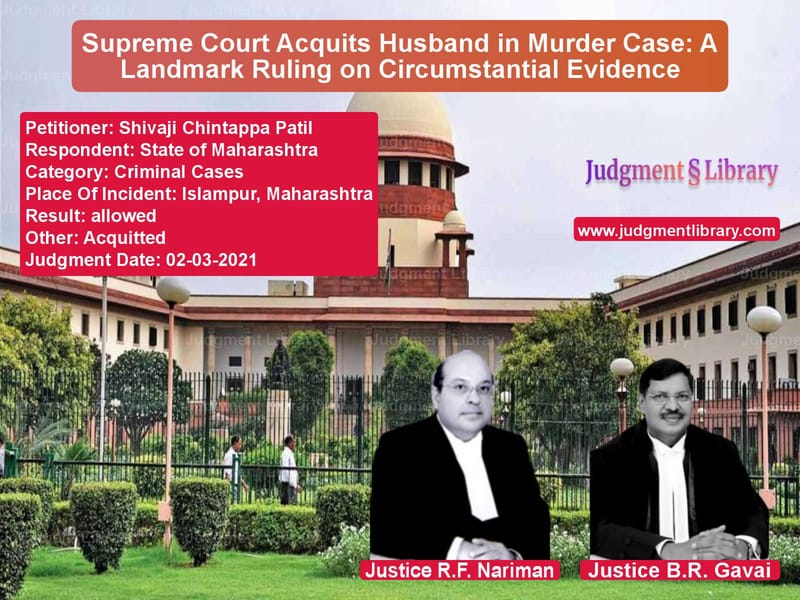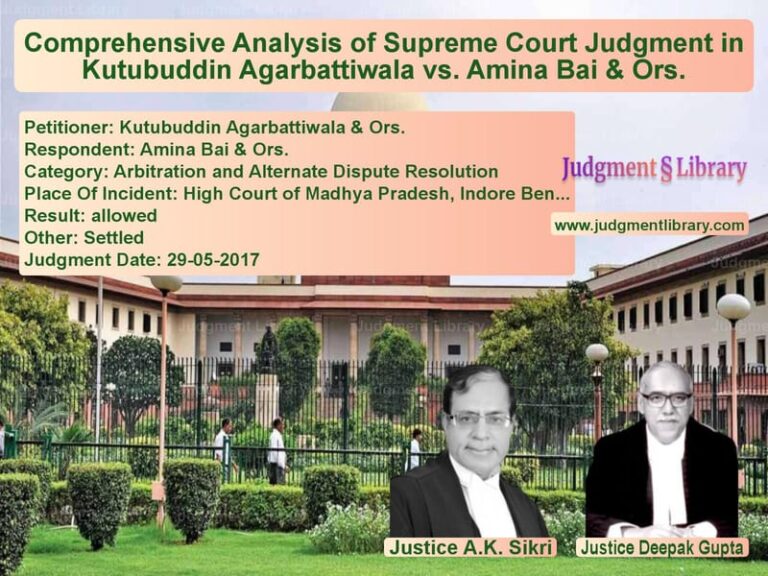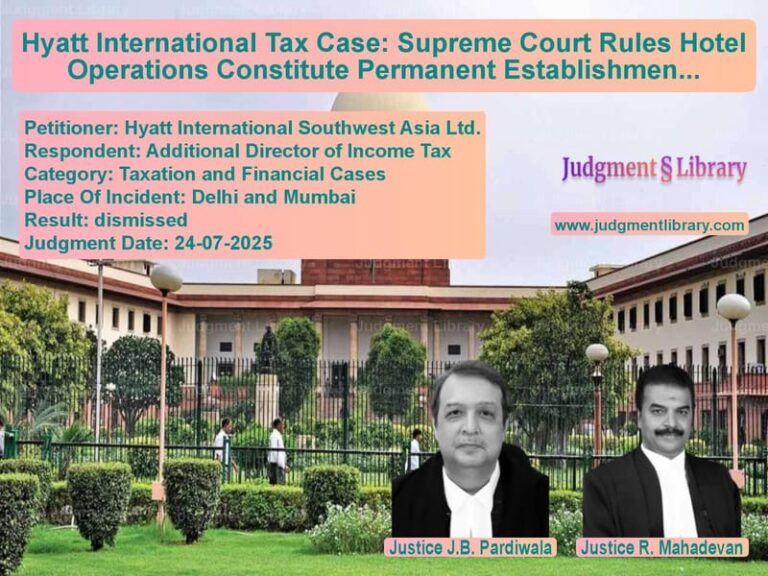Supreme Court Acquits Husband in Murder Case: A Landmark Ruling on Circumstantial Evidence
The Supreme Court of India, in a significant ruling, acquitted an accused in a murder case that relied solely on circumstantial evidence. The case of Shivaji Chintappa Patil vs. State of Maharashtra revolved around the unnatural death of the accused’s wife, Jayashree, which was initially treated as suicide but later alleged to be a case of homicide. The Court meticulously analyzed the principles of circumstantial evidence, burden of proof under Section 106 of the Evidence Act, and the necessity of proving motive.
Background of the Case
The case originated from an incident on March 24, 2003, in Islampur, Maharashtra. The prosecution alleged that Shivaji Chintappa Patil killed his wife, Jayashree, by strangulation. Initially, the death was reported as suicide, but upon further investigation, a case under Section 302 IPC (murder) was registered against the accused.
Read also: https://judgmentlibrary.com/legal-battle-over-cheating-and-assault-allegations-a-case-analysis/
The case was tried before the Additional Sessions Judge, Islampur, who convicted the accused and sentenced him to life imprisonment. The Bombay High Court upheld this conviction. Aggrieved, the accused appealed before the Supreme Court.
Arguments by the Petitioner (Shivaji Chintappa Patil)
- The case was based solely on circumstantial evidence without any direct proof linking the accused to the crime.
- The prosecution failed to establish a clear motive for the alleged murder.
- The medical reports contained conflicting opinions regarding the cause of death—whether it was suicide by hanging or homicide by strangulation.
- The accused was falsely implicated based on mere suspicion.
- The High Court and the trial court wrongly applied Section 106 of the Evidence Act without first proving that the death was homicidal.
Arguments by the Respondent (State of Maharashtra)
- The post-mortem report suggested that the cause of death was asphyxia due to strangulation.
- The accused was the only person present with the deceased on the night of the incident.
- The accused’s behavior after the death was suspicious, and he failed to provide a satisfactory explanation under Section 313 CrPC.
- The trial court and the High Court correctly applied the principle that the accused, being the last person with the deceased, bore the burden of explaining the circumstances of her death.
Supreme Court’s Observations
The Supreme Court extensively examined the law on circumstantial evidence and laid down the following key principles:
- Failure to Prove Homicidal Death: The Court ruled that the prosecution failed to prove beyond reasonable doubt that Jayashree’s death was a case of homicide.
- Conflicting Medical Opinions: The medical expert admitted that both suicidal hanging and homicidal strangulation could cause similar ligature marks. This ambiguity raised doubts about the prosecution’s version.
- Burden Under Section 106 of the Evidence Act: The Court clarified that the prosecution must first establish a prima facie case of homicide before shifting the burden of proof to the accused.
- Motive Not Established: In cases based on circumstantial evidence, motive plays a crucial role. The Court found that the alleged motive of financial disputes was not convincingly established.
- False Explanation Cannot Be a Substitute for Proof: The Court held that a false or incomplete explanation by the accused cannot be used as a primary basis for conviction unless the prosecution establishes an independent case.
The Court stated:
“In cases based on circumstantial evidence, the chain of events must be so complete that it leaves no reasonable doubt about the accused’s guilt. Mere suspicion, however strong, cannot take the place of proof.”
Supreme Court’s Verdict
- The Supreme Court set aside the conviction and sentence.
- The accused, Shivaji Chintappa Patil, was acquitted of all charges.
- The Court directed his immediate release if not required in any other case.
Impact of the Judgment
- Reinforcement of Circumstantial Evidence Principles: The ruling reiterates that a conviction cannot be based on weak circumstantial evidence.
- Clarification on Section 106 of the Evidence Act: The judgment sets a precedent that the burden of proof on the accused arises only after the prosecution has established a clear case of homicide.
- Protection Against Wrongful Conviction: The decision strengthens legal safeguards against wrongful convictions based on mere suspicion.
- Guidance for Future Cases: The ruling serves as a reference for courts handling cases based on circumstantial evidence, ensuring fair trials and just outcomes.
Conclusion
The Supreme Court’s decision in Shivaji Chintappa Patil vs. State of Maharashtra is a landmark ruling that underscores the necessity of proving every element of a case before convicting an accused. By emphasizing the role of medical evidence, circumstantial proof, and the correct application of the burden of proof, the Court has ensured that justice prevails. This case will serve as a guiding precedent for similar cases involving conflicting medical opinions and circumstantial evidence.
Petitioner Name: Shivaji Chintappa Patil.Respondent Name: State of Maharashtra.Judgment By: Justice R.F. Nariman, Justice B.R. Gavai.Place Of Incident: Islampur, Maharashtra.Judgment Date: 02-03-2021.
Don’t miss out on the full details! Download the complete judgment in PDF format below and gain valuable insights instantly!
Download Judgment: shivaji-chintappa-pa-vs-state-of-maharashtra-supreme-court-of-india-judgment-dated-02-03-2021.pdf
Directly Download Judgment: Directly download this Judgment
See all petitions in Murder Cases
See all petitions in Bail and Anticipatory Bail
See all petitions in Attempt to Murder Cases
See all petitions in Custodial Deaths and Police Misconduct
See all petitions in Judgment by Rohinton Fali Nariman
See all petitions in Judgment by B R Gavai
See all petitions in allowed
See all petitions in acquitted
See all petitions in supreme court of India judgments March 2021
See all petitions in 2021 judgments
See all posts in Criminal Cases Category
See all allowed petitions in Criminal Cases Category
See all Dismissed petitions in Criminal Cases Category
See all partially allowed petitions in Criminal Cases Category







